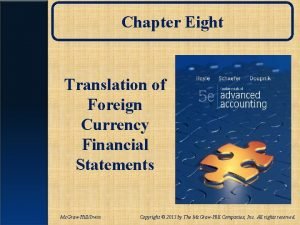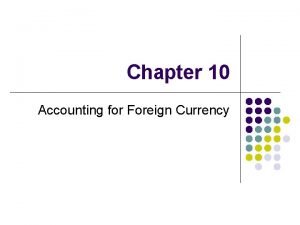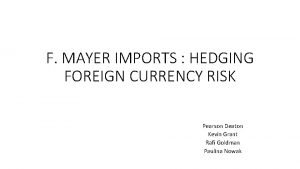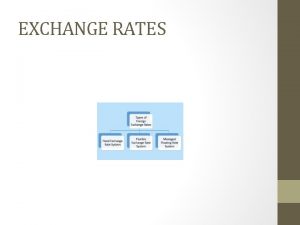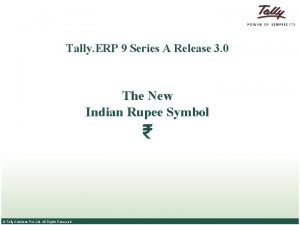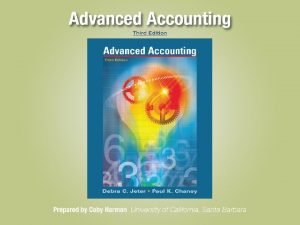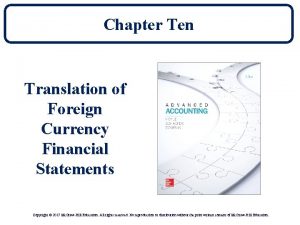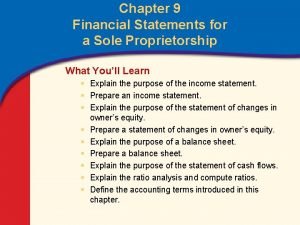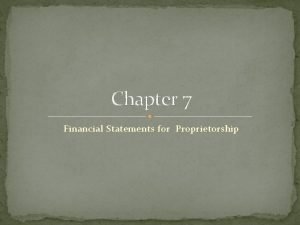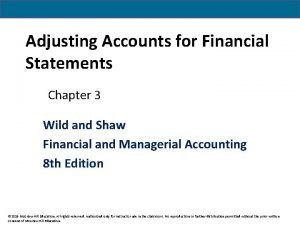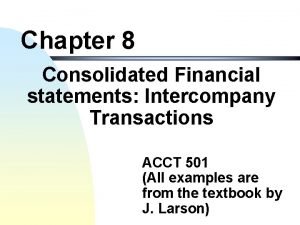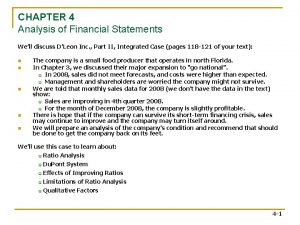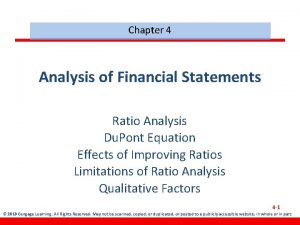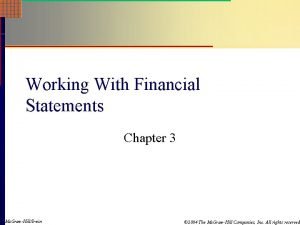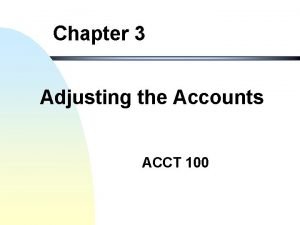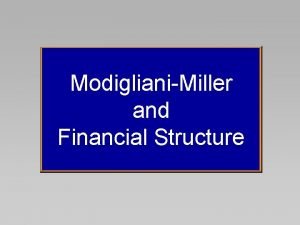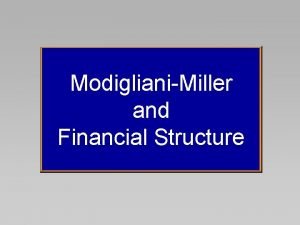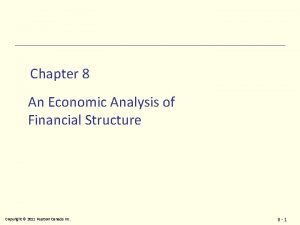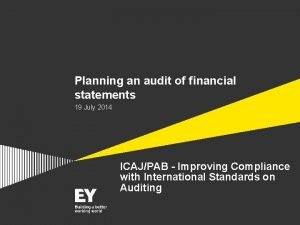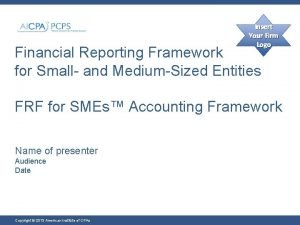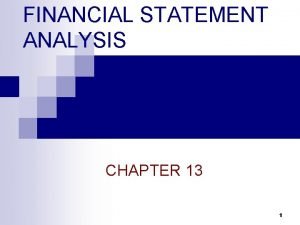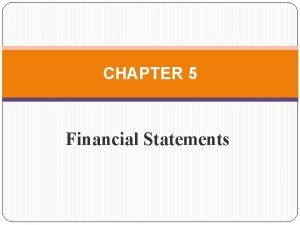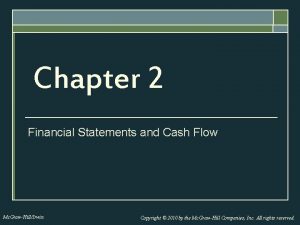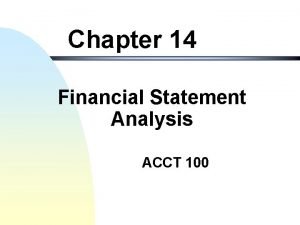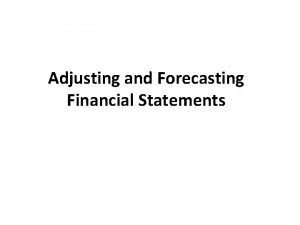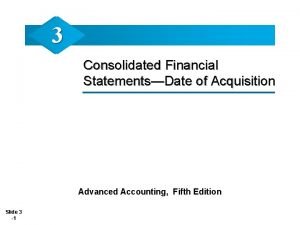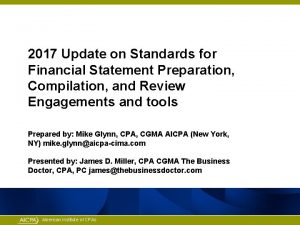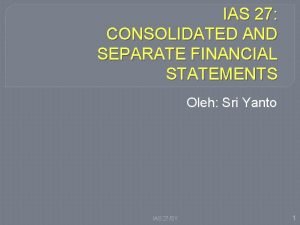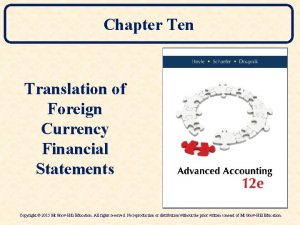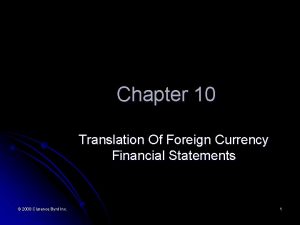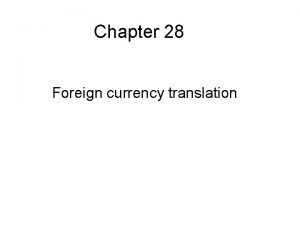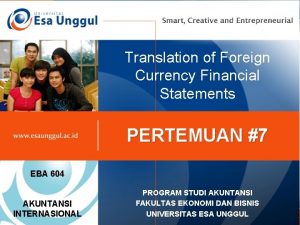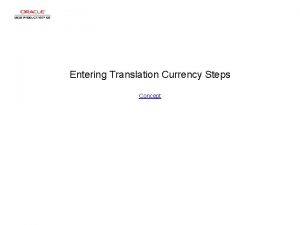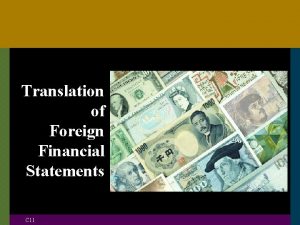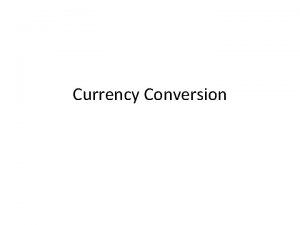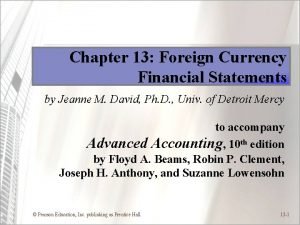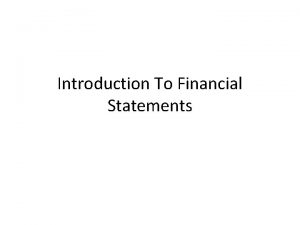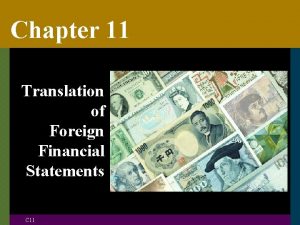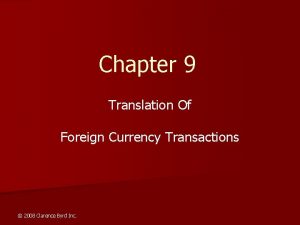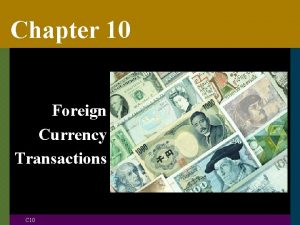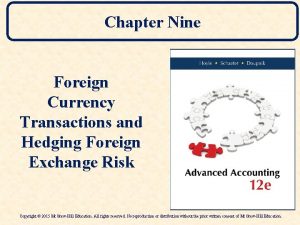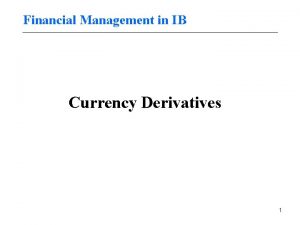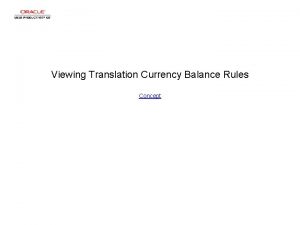Chapter Eight Translation of Foreign Currency Financial Statements













































- Slides: 45

Chapter Eight Translation of Foreign Currency Financial Statements Mc. Graw-Hill/Irwin Copyright © 2013 by The Mc. Graw-Hill Companies, Inc. All rights reserved.

Worldwide Consolidated Financial Statements To prepare worldwide consolidated financial statements a U. S. parent must: 1) convert the foreign GAAP financial statements of its foreign operations into U. S. GAAP and 2) translate the financial statements from the foreign currency into U. S. dollars. This conversion and translation process is required whether the foreign operation is a branch, joint venture, majority-owned subsidiary, or affiliate accounted for under the equity method. 8 -2

LO 1 Translation Methods: Temporal and Current Rate Two major translation methods are currently used: (1) the current rate (closing rate) method and (2) the temporal method. 8 -3

Treatments for Translation Adjustment The two major translation methods and the two possible treatments for the translation adjustment give rise to four possible combinations: 8 -4

LO 2 Two Translation Combinations Some subs use a U. S. dollar perspective to translation, so most of their transactions are recorded in U. S. dollars using the temporal method. Other subs use the local currency perspective; they operate relatively independent of their U. S. parents and use the current rate method for translation. Translation adjustment appears in the equity section. 8 -5

Functional Currency To determine whether a subsidiary is integrated with the parent or operates independently, we look at the functional currency. A company’s functional currency is the primary currency of the foreign entity’s operating environment. 8 -6

Determining a Subsidiary’s Functional Currency 8 -7

Highly Inflationary Economies In highly inflationary economies, the Temporal Method for translation is required. A country has a highly inflationary economy when its cumulative three year inflation exceeds 100 percent. With compounding, it equates to an average of approximately 26 percent per year for three years in a row. A country may or may not be classified as highly inflationary, depending on its most recent threeyear experience with inflation. 8 -8

LO 3 Current Rate Method Under the current rate method, all revenues and expenses are translated at the exchange rate in effect at the date of accounting recognition. The weighted average exchange rate is used when revenues and expenses have been recognized evenly throughout the year. However, when an income account, such as a gain or loss, occurs at a specific point in time, the exchange rate as of that date is applied. Depreciation and amortization expenses also are translated at the average rate for the year. These expenses accrue evenly throughout the year even though the journal entry could be delayed until year-end for convenience. 8 -9

Current Rate Method Example USCO (a U. S. -based company) forms a wholly owned subsidiary in Switzerland (SWISSCO) on December 31, 2012. On that date, USCO invested $300, 000 in exchange for all of the subsidiary’s common stock. The exchange rate was $0. 60 per Swiss franc (CHF), the initial capital investment was CHF 500, 000, of which CHF 150, 000 was immediately invested in inventory and the remainder held in cash. Thus, SWISSCO began operations on January 1, 2013, with stockholders’ equity (net assets) of CHF 500, 000 and net monetary assets of CHF 350, 000. 8 -10

Current Rate Method Example To translate the Swiss franc financial statements into U. S. dollars, USCO needs exchange rates for the Swiss franc and U. S. dollar. Relevant exchange rates (in U. S. dollars) are as follows: January 1, 2013. . . $0. 60 Rate when property and equipment were acquired and long-term debt was incurred, March 15, 2013. . . . . 0. 61 Rate when patent was acquired, April 10, 2013. . . . . 0. 62 Average 2013. . . 0. 65 Rate when dividends were declared, October 1, 2013. . . 0. 67 Average fourth quarter 2013. . . . . 0. 68 December 31, 2013. . . . . 0. 70 As you can see, the Swiss franc steadily appreciated against the dollar during the year. 8 -11

Current Rate Method Example The first step in translating foreign currency financial statements is to determine the functional currency. Assuming the Swiss franc is the functional currency, the income statement and statement of retained earnings are translated into U. S. dollars using the current rate method. 8 -12

Current Rate Method Example Income Statement *Indicates the exchange rate used and whether the rate is the current (C), average (A), or a historical (H) rate. 8 -13

Current Rate Method Example Income Statement Weighted average (A) rates are generally used for Sales, COGS, and other recurring expenses. *Indicates the exchange rate used and whether the rate is the current (C), average (A), or a historical (H) rate. 8 -14

Current Rate Method Example 1. Beginning R/E (if any) is carried over from prior year. 2. Net income is taken from the income statement. 3. Dividends are translated at the rate in effect at the time the dividends were declared. Retained Earnings *Indicates the exchange rate used and whether the rate is the current (C), average (A), or a historical (H) rate. 8 -15

Current Rate Method Example Balance Sheet *Indicates the exchange rate used and whether the rate is the current (C), average (A), or a historical (H) rate. 8 -16

Current Rate Method Example All assets and liabilities are translated at the current rate (C) on the balance sheet date. *Indicates the exchange rate used and whether the rate is the current (C), average (A), or a historical (H) rate. 8 -17

Current Rate Method Example Balance Sheet continued. . . Common Stock is translated at the historical rate (H) at the time the stock was issued. The Ending R/E comes from the statement of retained earnings. *Indicates the exchange rate used and whether the rate is the current (C), average (A), or a historical (H) rate. 8 -18

Current Rate Method Example Statement of Cash Flows *Indicates the exchange rate used and whether the rate is the current (C), average (A), or a historical (H) rate. 8 -19

Current Rate Method Example Statement of Cash Flows The $(4, 500) “effect of exchange rate change on cash” is a part of the overall translation adjustment of $69, 000. It represents the translation adjustment attributable to a decrease in Cash and is derived as a balancing amount. *Indicates the exchange rate used and whether the rate is the current (C), average (A), or a historical (H) rate. 8 -20

Current Rate Method Example The translation adjustment = the difference between (c) and (d). If c > d, a debit (negative) adjustment is recognized; if d > c, a credit (positive) adjustment is recognized. 8 -21

LO 4 Temporal Method If the sub’s functional currency is the US $, then any balances denominated in the local currency, must be remeasured. Remeasurement requires the application of the temporal method. The remeasurement gain or loss appears on the income statement. 8 -22

Temporal Method The temporal method remeasures cash, receivables, and liabilities into U. S. dollars using the current exchange rate. Inventory, property and equipment, patents, and contributed capital accounts are remeasured at historical rates resulting in differences in total assets and liabilities plus equity which must be reconciled resulting in a remeasurement gain or loss. 8 -23

Temporal Method Example Now assume that SWISSCO’s functional currency is the U. S. dollar. The Swiss franc financial statements must be remeasured into U. S. dollars using the temporal method and the remeasurement gain or loss reported in income. In that case, it is easiest to remeasure the balance sheet first. 8 -24

Temporal Method Example Balance Sheet 8 -25

Temporal Method Example Income Statement 8 -26

Temporal Method Example On the income statement, cost of goods sold is remeasured at historical exchange rates. Beginning inventory is remeasured at the exchange rate on that date ($0. 60). Purchases made throughout the year are remeasured at the average rate for the year ($0. 65). Ending inventory (at FIFO cost) is purchased throughout the fourth quarter of 2013; the average exchange rate for the quarter ($0. 68) is used to remeasure that component of cost of goods sold. These procedures result in Cost of Goods Sold of $1, 930, 500, calculated as: 8 -27

Temporal Method Example The ending balances in Retained Earnings on the balance sheet and on the statement of retained earnings must reconcile with one another. Dividends are remeasured into a U. S. dollar equivalent of $100, 500, the ending balance in Retained Earnings on the balance sheet is $181, 800, and net income is $282, 300. Retained Earnings 8 -28

Temporal Method Example Reconciling income reported in Retained Earnings and on the income statement requires a remeasurement loss of $47, 000 when calculating net income. 8 -29

Temporal Method In remeasuring the statement of cash flows, the U. S. dollar value for net income is taken from the remeasured income statement. Depreciation and amortization are remeasured at the rates used in the income statement, and the remeasurement loss, a noncash item, is added back to net income. Increases in accounts receivable and accounts payable, related to sales and purchases, are remeasured at the average rate. The increase in inventory is determined by the remeasurement of cost of goods sold. 8 -30

Temporal Method Example Statement of Cash Flows 8 -31

Temporal Method Example Statement of Cash Flows The U. S. dollar amount of “net cash from operations” ($474, 500) is exactly the same as when the current rate method was used in translation. The investing and financing activities are translated in the same manner under both methods. 8 -32

LO 1 Comparison of Results from Applying the Two Methods If the Swiss franc is the SWISSCO’s functional currency (current rate method), consolidated net income, total assets, and total equity would be higher than if the U. S. dollar was the functional currency (temporal method). Return on equity would be less. 8 -33

Nonlocal Currency Balances If any accounts of the foreign subsidiary are denominated in a currency other than the local currency (or the US$), they would first have to be restated into the local currency. Both the foreign currency balance and any related foreign exchange gain or loss would then be translated (or remeasured) into US$. 8 -34

LO 5 Hedging Balance Sheet Exposure Translation adjustments and re-measurement gains / losses arise from: (1) Exchange rate changes and (2) Balance sheet exposure can be hedged through derivatives (forward contracts or foreign currency options) or through nonderivative instruments (foreign currency borrowings). Ironically, in seeking to avoid unrealized translation adjustments, realized foreign exchange gains and losses can occur! 8 -35

LO 6 Consolidation of a Foreign Subsidiary On January 1, 2012, Altman, Inc. , a U. S. -based manufacturing firm, acquired 100 percent of Bradford Ltd. in Great Britain. Altman paid £ 25, 000, which was equal to Bradford’s fair value. Bradford’s balance sheet on January 1, 2012, was as follows: Cash. . . . £ 925, 000 Accounts payable. . . £ 675, 000 Accounts receivable. . . 1, 400, 000 Long-term debt. . . 4, 000 Inventory. . . 6, 050, 000 Common stock. . . 20, 000 Plant & equipment (net) 19, 000 Retained earnings. . 2, 700, 000 Total. . . . £ 27, 375, 000 Total. . . £ 27, 375, 000 The £ 2, 300, 000 excess fair value over book value results from undervalued land (part of plant and equipment) and is not subject to amortization. Altman uses the equity method to account for its investment in Bradford. 8 -36

Consolidation of a Foreign Subsidiary On December 31, 2013, two years after the acquisition date, Bradford submitted the following trial balance for consolidation (credit balances are in parentheses): Cash. . . . £ 600, 000 Accounts Receivable. . . . . 2, 700, 000 Inventory. . . . 9, 000 Plant and Equipment (net). . . 17, 200, 000 Accounts Payable. . . (500, 000) Long-Term Debt. . . (2, 000) Common Stock. . . (20, 000) Retained Earnings, 1/1/13. . . . (3, 800, 000) Sales. . . . (13, 900, 000) Cost of Goods Sold. . . . . 8, 100, 000 Depreciation Expense. . . . . 900, 000 Other Expenses. . . 950, 000 Dividends Declared, 6/30/13. . . . 750, 000 £ -08 -37

LO 6 Consolidation of a Foreign Subsidiary Although Bradford generated net income of £ 1, 100, 000 in 2012, it declared or paid no dividends that year. Other than the payment of dividends in 2013, no intraentity transactions occurred between the two affiliates. Altman has determined the British pound to be Bradford’s functional currency. Relevant exchange rates for the British pound were: January 1 June 30 December 31 Average 2012 $1. 51 – 0– $1. 56 $1. 54 2013 1. 56 $1. 58 1. 53 1. 55 8 -38

Consolidation of a Foreign Subsidiary The initial step in consolidating the foreign subsidiary is to translate its trial balance from British pounds into U. S. dollars. Because the British pound is the functional currency, the translation uses the current rate method. The historical exchange rate for translating Bradford’s common stock and January 1, 2012, retained earnings is the exchange rate that existed at the acquisition date—$1. 51. 8 -39

Consolidation of a Foreign Subsidiary Translation of Foreign Subsidiary Trial Balance 8 -40

Consolidation of a Foreign Subsidiary Translation of Foreign Subsidiary Trial Balance 8 -41

Consolidation of a Foreign Subsidiary Altman records these entries on its balance sheet. 8 -42

LO 7 Consolidation Worksheet with Foreign Subsidiary 8 -43

IFRS and Translations IFRS and US GAAP are consistent on most points, however under IAS 21. . . 1. IFRS has a hierarchy of characteristics for determining the functional currency. 2. The method used to translate statements from a hyperinflationary country differs. 8 -44

Summary The translation of foreign currency financial statements is an important accounting challenge in the current global environment. The two primary methods used are the temporal and current rate methods. When the foreign operation’s functional currency is their local currency, use the current rate method. Use the temporal method when the operation’s functional currency is the US$, or in the case of a highly inflationary economy. 8 -45
 Financial statement translation example
Financial statement translation example Foreign exchange accounting
Foreign exchange accounting F mayer imports case study solution
F mayer imports case study solution Exchnage rate
Exchnage rate Rupee symbol in tally
Rupee symbol in tally Translating financial statements
Translating financial statements Translation of financial statements
Translation of financial statements Whats a plane figure
Whats a plane figure A short section of corrugated roadway that warns of hazards
A short section of corrugated roadway that warns of hazards So here you are too foreign for home
So here you are too foreign for home Chapter 03 financial analysis
Chapter 03 financial analysis Fees earned debit or credit
Fees earned debit or credit Financial statement of sole proprietorship
Financial statement of sole proprietorship Chapter 7 financial statements for a proprietorship
Chapter 7 financial statements for a proprietorship Adjusting accounts for financial statements
Adjusting accounts for financial statements Chapter 8 separate financial statements
Chapter 8 separate financial statements Chapter 4 analysis of financial statements
Chapter 4 analysis of financial statements Chapter 4 analysis of financial statements
Chapter 4 analysis of financial statements Financial statements and ratio analysis chapter 3
Financial statements and ratio analysis chapter 3 Chapter 2 financial statements taxes and cash flow
Chapter 2 financial statements taxes and cash flow Working with financial statements chapter 3
Working with financial statements chapter 3 Chapter 3 adjusting accounts for financial statements
Chapter 3 adjusting accounts for financial statements Adjusting entry accrued expense
Adjusting entry accrued expense Eight basic puzzles about financial structure
Eight basic puzzles about financial structure Eight basic puzzles about financial structure
Eight basic puzzles about financial structure Eight basic facts about financial structure
Eight basic facts about financial structure Eight basic facts about financial structure
Eight basic facts about financial structure Eight basic facts about financial structure
Eight basic facts about financial structure Types of exchange rate
Types of exchange rate Communicative theory of translation
Communicative theory of translation Cisco voice translation-rule
Cisco voice translation-rule Parent function of linear
Parent function of linear Noun phrase
Noun phrase Financial statement purpose
Financial statement purpose Planning an audit of financial statements
Planning an audit of financial statements Sample notes to financial statements for small entities
Sample notes to financial statements for small entities Chapter 13 financial statement analysis
Chapter 13 financial statement analysis Objectives of financial statements
Objectives of financial statements 2-2 journal: financial statements and cash flow management
2-2 journal: financial statements and cash flow management Where is preferred dividends on financial statements
Where is preferred dividends on financial statements Forecasted financial statements
Forecasted financial statements Consolidated financial statements date of acquisition
Consolidated financial statements date of acquisition Ssars 21 engagement letter example
Ssars 21 engagement letter example Principles assumptions and constraints of accounting
Principles assumptions and constraints of accounting Ias consolidated financial statements
Ias consolidated financial statements Standardized income statement
Standardized income statement
